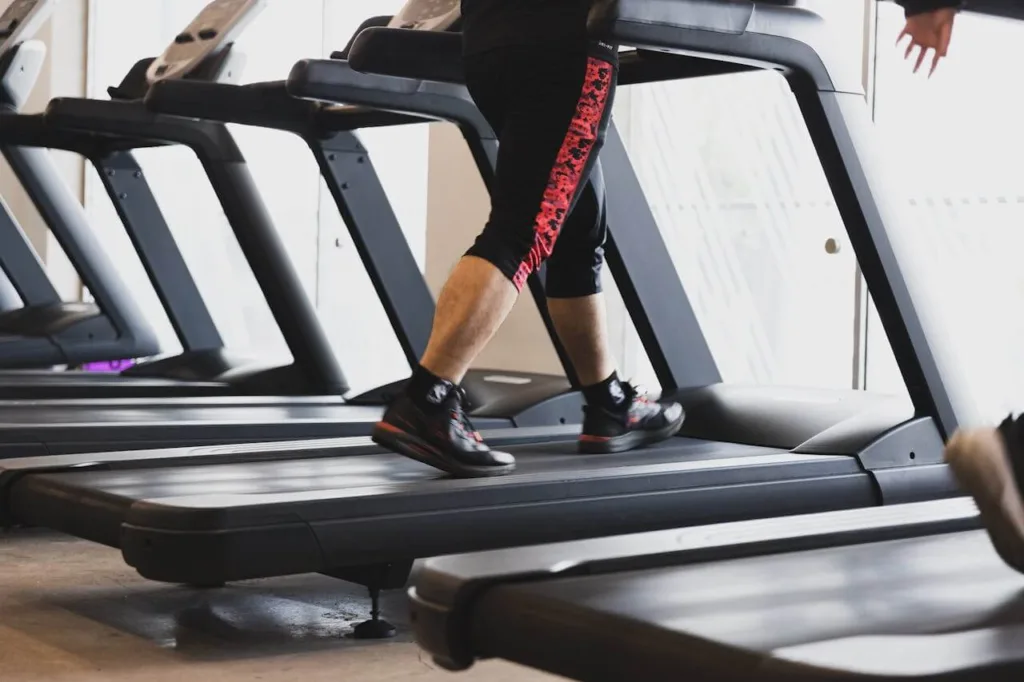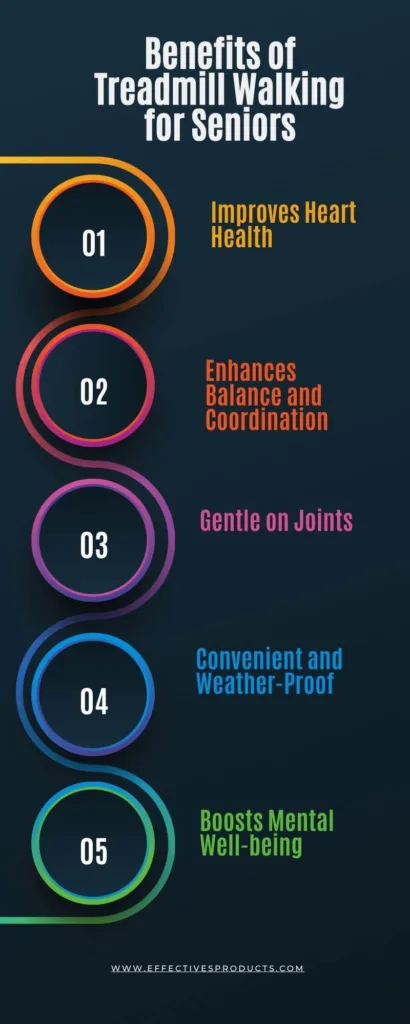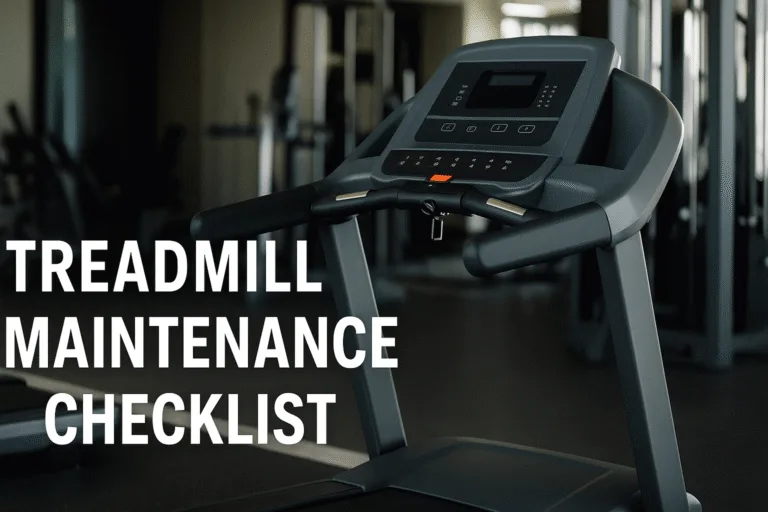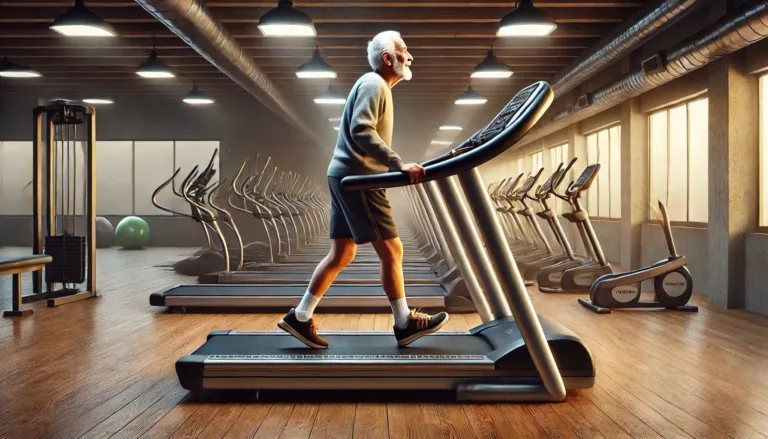Treadmill walking is a fantastic low-impact exercise for seniors who want to stay active and enhance their overall health. Whether you’re just beginning your fitness journey or looking to establish a regular routine, a treadmill walking workout for seniors can bring you many benefits, like improved cardiovascular health, better balance, and increased mobility.
In this guide, we’ll help you discover helpful safety tips, a sample workout plan, and advice on how to progress safely over time.

What Safety Tips Should Seniors Follow Before Treadmill Walking?
Before starting a treadmill walking workout for seniors, following a few safety tips is important. These precautions help prevent injury, ensure comfort, and make the exercise experience more effective and enjoyable.
- Consult Your Doctor: Always check with your healthcare provider before starting a new exercise routine, especially if you have existing health conditions like high blood pressure, heart disease, or joint issues.
- Wear Proper Walking Shoes: Choose comfortable, supportive footwear with good grip and cushioning. This reduces the risk of slipping and helps protect your feet and joints.
- Start Slow and Warm Up
- Begin each workout with 5 minutes of slow-paced walking to gradually increase your heart rate and loosen your muscles. Avoid jumping into fast speeds right away.
- Use the Handrails Safely: It’s okay to use handrails for balance when starting, but try not to grip them tightly. Let your arms swing naturally to improve posture and walking efficiency.
- Check Treadmill Settings: Set the treadmill to a slow speed (1.5–2.0 mph) when you’re starting. Keep the incline at 0% until you’re comfortable increasing intensity gradually.
- Stay Hydrated: Keep a water bottle nearby and take sips as needed. Hydration helps maintain energy levels and prevents cramps or dizziness.
- Avoid Multitasking: Don’t read, watch videos, or talk on the phone while walking. Staying focused improves balance and safety.
- Know How to Stop the Treadmill: Familiarize yourself with the stop button and the safety clip. If you feel unwell, slow down or stop immediately.
What Are the Benefits of Treadmill Walking for Seniors?

It is important for Old age people to do some type of exercise every day to improve their health. A treadmill walking workout for seniors offers several health benefits. It’s a safe, low-impact exercise that supports heart health, joint mobility, balance, and mental well-being. It also allows seniors to stay active indoors, regardless of weather or outdoor conditions.
- Improves Heart Health: Regular treadmill walking strengthens the heart, helps regulate blood pressure, and improves circulation. It supports overall cardiovascular wellness without putting too much stress on the body.
- Enhances Balance and Coordination: Walking on a flat, even surface helps seniors improve balance and reduce the risk of falls. Over time, it can also boost coordination and leg strength.
- Gentle on Joints: Compared to outdoor surfaces like concrete, treadmill walking offers a cushioned surface that reduces joint stress. This is especially helpful for seniors with arthritis or joint pain.
- Supports Weight Management: Consistent walking can help burn calories and maintain a healthy weight, which is crucial for reducing the risk of chronic conditions like diabetes and heart disease.
- Convenient and Weather-Proof: One of the best advantages of a treadmill walking workout is that it can be done indoors, no need to worry about rain, heat, or uneven sidewalks.
- Boosts Mental Well-being: Walking helps release endorphins, which improve mood and reduce feelings of stress, anxiety, and depression, common concerns among older adults.
How to Set Up the Treadmill for Seniors
1. Choose the Right Location
- Place the treadmill in a well-lit, quiet, and clutter-free area.
- Ensure there is enough space on all sides for safe mounting and dismounting.
2. Adjust the Speed
- Start with a low speed setting between 1.5 to 2.0 mph.
- As you build confidence, you can gradually increase the speed based on comfort and ability.
3. Set the Incline to 0%
- Begin walking on a flat surface to minimize strain on the knees and back.
- You can gradually increase the incline (up to 1% or 2%) to improve strength and endurance, but only when you’re ready.
4. Use the Safety Key
- Always attach the safety clip to your clothing. This will stop the treadmill automatically if you stumble or lose balance.
5. Wear Comfortable Workout Gear
- Lightweight, breathable clothing and walking shoes with non-slip soles help you stay comfortable and safe.
6. Keep Essentials Nearby
- Have water, a towel, and your phone (in case of emergency) within reach.
- Some treadmills also have heart rate monitors and built-in programs tailored for walking—these can be helpful if available.
7. Warm Up and Cool Down
- Include at least 5 minutes at the beginning and end of each workout at a very slow pace to warm up and cool down properly.
Sample Treadmill Walking Workout for Seniors
A well-structured plan makes a treadmill walking workout for seniors both safe and effective. We designed the following beginner-friendly routine with experts for comfort, gradual progression, and heart health.
Beginner 30-Minute Treadmill Walking Routine
| Time (min) | Speed (mph) | Incline | Activity |
| 0–5 | 1.5 | 0% | Warm-up walk |
| 5–10 | 2.0 | 0% | Comfortable pace |
| 10–15 | 2.2 | 1% | Moderate pace |
| 15–20 | 2.0 | 0% | Recovery walk |
| 20–25 | 2.2 | 1% | Moderate pace |
| 25–30 | 1.5 | 0% | Cool-down walk |
Follow these steps:
- Warm-Up (0–5 minutes):
Walk at a slow pace (1.5 mph) with 0% incline to loosen your muscles. - Easy Walk (5–10 minutes):
Increase speed slightly to 2.0 mph. Maintain a steady, relaxed pace. - Moderate Walk (10–15 minutes):
Walk at 2.2 mph and add a 1% incline to gently raise your heart rate. - Recovery Walk (15–20 minutes):
Lower speed back to 2.0 mph and incline to 0%. Catch your breath. - Second Moderate Walk (20–25 minutes):
Return to 2.2 mph with a 1% incline to re-engage your muscles. - Cool Down (25–30 minutes):
Finish with a slow pace (1.5 mph) and 0% incline to cool down safely.
If 30 minutes feels too long at first, start with 10–15 minutes and build up gradually over time.
This treadmill walking workout for seniors is safe, easy to follow, and can be adjusted to suit your fitness level.
How to Progress Safely Over Time
Once you’ve gotten comfortable with your beginner treadmill walking routine, you may want to improve your endurance, strength, or overall fitness level. The key is to progress gradually and listen to your body.
Here are some practical tips to help you advance your treadmill walking workout for seniors safely:
Increase Time Before Speed
If your current workout feels too easy, try adding 2 to 5 minutes to your session before increasing the treadmill speed. Building endurance first is safer and more effective than jumping to higher speeds too soon.
Introduce Incline Gradually
Adding incline helps strengthen muscles and boost cardiovascular fitness. Start with a 1% incline for short intervals, then return to flat walking. Over time, you can increase both the incline level and the duration.
Follow a Weekly Routine
Aim for 3 to 5 walking sessions per week. Consistency is more important than intensity. Allow at least one rest day between workouts to help your body recover and avoid fatigue.
Listen to Your Body
Mild muscle soreness after a workout is normal, but sharp pain, dizziness, or fatigue are warning signs to slow down or rest. Always pay attention to how you feel during and after each session.
Track Your Progress
Keep a simple log of your workouts, noting the duration, speed, and how you felt afterward. This helps you see your improvement over time and stay motivated.
Mix It Up
As you build confidence, try varying your workouts. For example, alternate between longer, slow-paced walks and shorter sessions with moderate inclines. This variety keeps things interesting and works different muscle groups.
When to Avoid Treadmill Walking
While a treadmill walking workout for seniors is generally safe, there are times when it’s best to pause or skip your session. Ignoring these signs can lead to injury or worsen existing health conditions.
Avoid treadmill walking if you:
- Feel dizzy or lightheaded
Dizziness can indicate dehydration, low blood pressure, or other underlying issues. Stop walking immediately and rest. - Experience joint pain or swelling
Pain in the knees, hips, or ankles may signal overuse or inflammation. Continuing could cause further damage. - Have flu-like symptoms or a fever
Exercising while sick puts stress on your immune system. Wait until you’re fully recovered. - Struggle with balance or coordination
If you’re having difficulty staying steady, treadmill walking may increase your risk of falling. Consider balance training or walking with assistance first. - Notice unusual fatigue
Excessive tiredness during or after a workout may be a sign to slow down, reduce intensity, or rest for a few days.
- If you were advised by your doctor to avoid exercise
Always follow medical advice, especially if you have heart conditions, respiratory problems, or are recovering from surgery.
Conclusion
A treadmill walking workout for adults is an excellent way to stay active, improve health, and maintain independence as you age. With its low-impact nature, ease of use, and the ability to adjust intensity, a treadmill offers seniors a safe and effective way to get regular exercise from the comfort of home.
By following the right safety tips, starting slow, and progressing gradually, seniors can enjoy the many benefits of treadmill walking without the risk of injury. Remember, consistency is key — even short, regular walks can have a lasting positive impact on heart health, balance, and overall well-being.
Start today with a simple treadmill walking routine, and over time, you’ll notice improvements in both your physical and mental health. Stay safe, stay motivated, and enjoy your journey to better fitness.
Frequently Asked Questions (FAQ)
Can a 70-year-old use a treadmill safely?
Yes, a 70-year-old can safely use a treadmill with proper precautions. Starting at a low speed, using the handrails for balance, and consulting a doctor first are key safety steps.
How long should a senior walk on a treadmill?
Most seniors benefit from walking 20 to 30 minutes per session, 3 to 5 times per week. Beginners can start with 10 to 15 minutes and increase gradually based on comfort.
What speed should a senior walk on a treadmill?
A safe starting speed is between 1.5 and 2.0 mph. Seniors can increase speed slowly as fitness improves, but comfort and stability should always come first.
Is walking on a treadmill better than walking outside for seniors?
Treadmill walking is safer for many seniors because it offers a flat, controlled surface and can be done indoors, regardless of the weather. It also reduces fall risk and joint strain.
Should seniors walk on an incline?
Seniors can walk on a slight incline (1–2%) once they are comfortable with flat walking. Inclines help build strength but should be introduced slowly to avoid strain.





